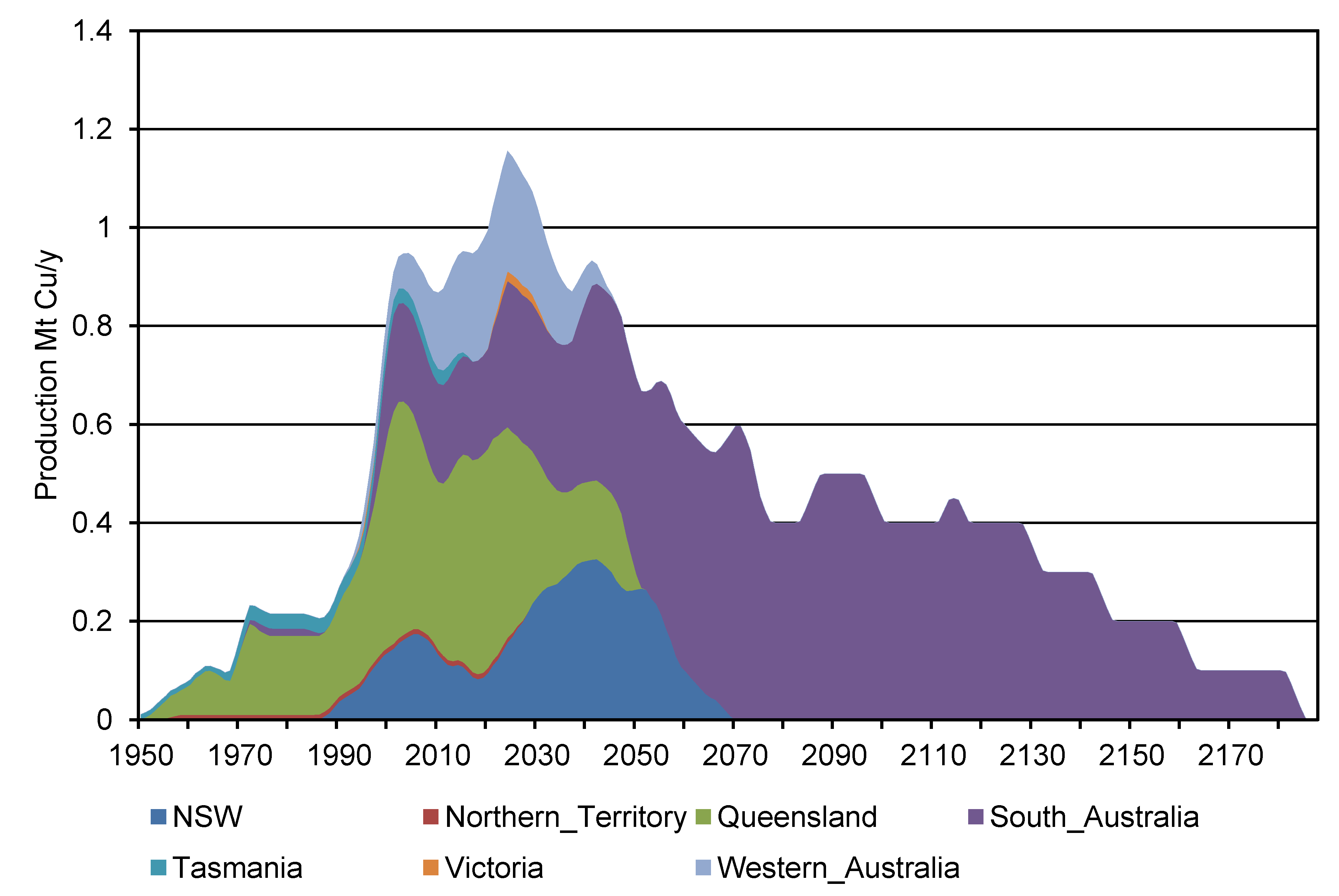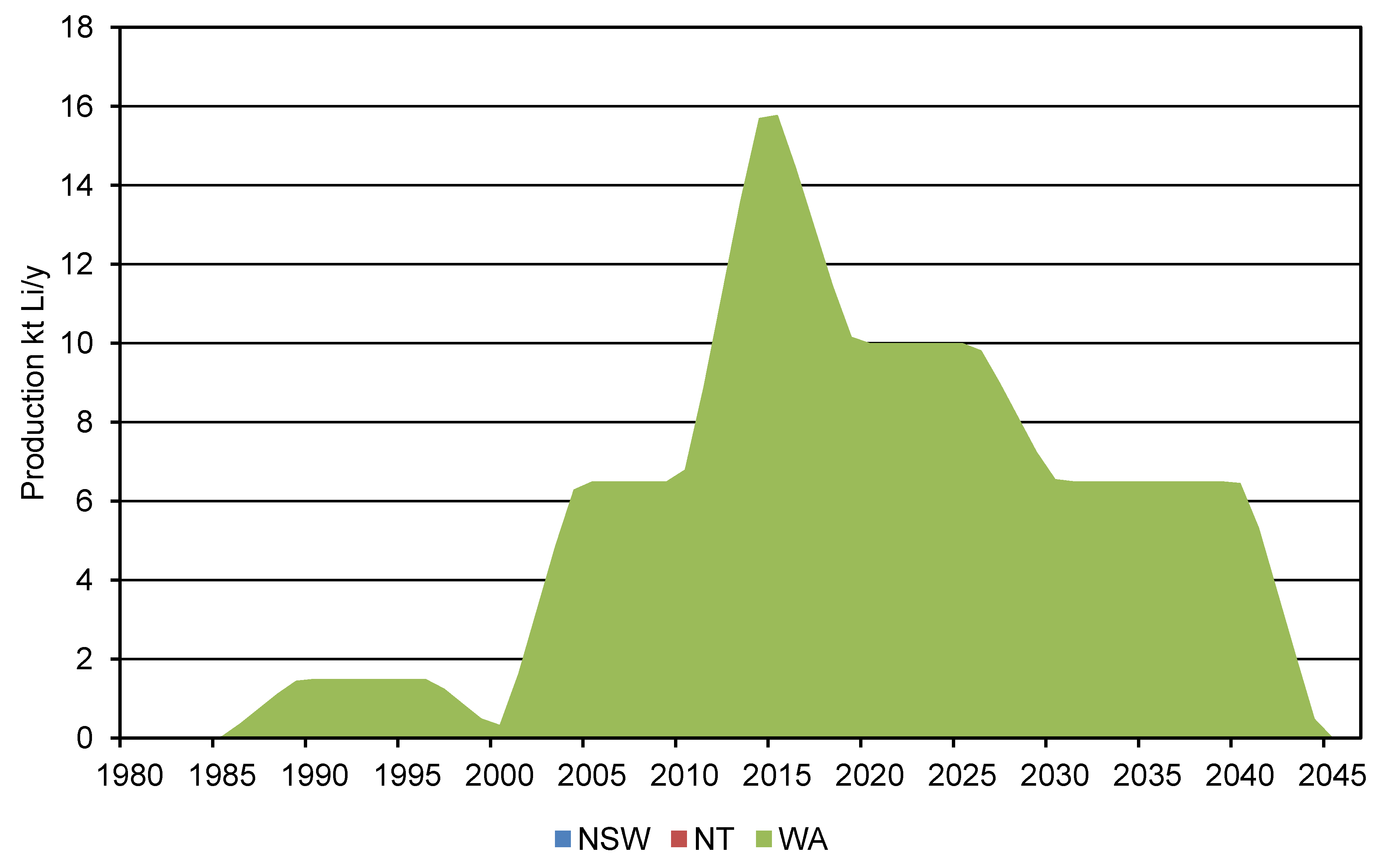Resource Criticality and Commodity Production Projections
Abstract
:1. Introduction
Aim
2. Peak Minerals and Resource Criticality
2.1. Background to Peak Minerals
- A progression from cheaper easier processing to more complex and expensive;
- The need for transition post-peak, both in terms of:
- - finding substitutes for providing the services for which the metals were used;
- - considering alternatives to the mining industry for providing economic growth;
- Both a regional or national scale—a global peak analysis (as is common for oil) need not be the default scale of a peak analysis.
2.2. Criticality Framework: Availability, Addiction, Alternatives
- Availability of the resource: This included both geological availability and limits to accessibility which could arise through limited capital and infrastructure for developing the resource, but also limited access where prevented through land use conflict.
- Addiction to resource use by society: This reflected both demand for the resource (and associated revenues) and the extent to which end uses for the metal (and monies) are pervasive and critical in society—the higher the addiction, the more difficult it could be to make a transition post-peak.
- Alternatives for transition: This referred to the potential to substitute terrestrial ore reserves with alternatives—for example ocean based resources, recycled scrap, dematerialization or substitution with another metal or non-metal to fulfill the function.
2.3. Production Projections: Geologic Resource Supply-Demand Model
3. Results
3.1. Peak Production Projections





| Type | Peak Year | Max Producation | Units |
|---|---|---|---|
| Coal | 2060 | 1.1 | Gt/year |
| Copper | 2024 | 1.2 | Mt Cu/year |
| Gold | 2021 | 420 | t Au/year |
| Iron | 2039 | 850 | Mt Fe Ore/year |
| Lithium | 2015 | 15.8 | kt Li/year |
3.2. Comparing Availability, Addiction, Alternatives
- (i) Are the resources available at an acceptable economic, social and environmental cost to meet national needs?
- (ii) Where exported to meet international demand—how are both the metals and monies derived from mining and minerals processing used?
- (iii) Are the global end-uses of metal being used within ethical supply chains to meet basic human needs or discretionary desires, and are they being used efficiently (taking account of dematerialization) in uses that help add to the stocks of natural, manufactured, financial, human and social capital?
- (iv) Are the monies derived from mining used to underpin the long term prosperity and sustainability of the nation—is such use in line with weak or strong sustainability?
| Commodity | Availability | Addiction | Alternatives | Issue for Australia |
|---|---|---|---|---|
| Coal |
|
|
|
|
| Copper |
|
|
|
|
| Gold |
|
|
|
|
| Iron/Steel |
|
|
|
|
| Lithium |
|
|
|
|
| Phosphorous |
|
|
|
|
4. Conclusions
Acknowledgments
References
- Mohr, S. Projection of World Fossil Fuel Production with Supply and Demand Interactions.
- Mason, L.; Prior, T.; Mudd, G.; Giurco, D. Availability, addiction and alternatives: Three criteria for assessing the impact of peak minerals on society. J. Clean. Prod. 2011, 19, 958–966. [Google Scholar] [CrossRef]
- ABARES, Australian Commodity Statistics; Australian Bureau of Agricultural and Resource Economics and Sciences: Canberra, Australia, 2010.
- Prior, T.; Giurco, D.; Mudd, G.; Mason, L.; Behrisch, J. Resource depletion, peak minerals and the implications for sustainable resource management. Glob. Environ. Chang. 2012, 22, 577–587. [Google Scholar] [CrossRef]
- Access Economics, Global Commodity Demand Scenarios; Minerals Council of Australia: Canberra, Australia, 2008.
- BREE, Resources and Energy Quarterly, September Quarter 2012; Bureau of Resources and Energy Economics: Canberra, Australia, 2012.
- Giurco, D.; Prior, T.; Mudd, G.; Mason, L.; Behrisch, J. Peak Minerals in Australia: A Review of Changing Impacts and Benefits; Institute for Sustainable Futures, University of Technology, Sydney: Broadway, Australia, 2010. [Google Scholar]
- Mudd, G.M.; Ward, J.D. Will Sustainability Constraints Cause “Peak Minerals”? In Proceedings of3rd International Conference on Sustainability Engineering and Science: Blueprints for Sustainable Infrastructure, Auckland, New Zealand, 9–12 December 2008.
- May, D.; Prior, T.; Cordell, D.; Giurco, D. Peak minerals: Theoretical foundations and practical application. Nat. Resour. Res. 2011, 21, 43–60. [Google Scholar]
- Graedel, T.E.; Barr, R.; Chandler, C.; Chase, T.; Choi, J.; Christoffersen, L.; Friedlander, E.; Henly, C.; Jun, C.; Nassar, N.T.; et al. Methodology of metal criticality determination. Environ. Sci. Technol. 2011, 46, 1063–1070. [Google Scholar]
- Mohr, S.H.; Evans, G.M. Forecasting coal production until 2100. Fuel 2009, 88, 2059–2067. [Google Scholar]
- Mohr, S.H.; Evans, G.M. Long term forecasting of natural gas production. Energy Policy 2011, 39, 2059–2067. [Google Scholar]
- Mohr, S.H.; Mudd, G.M.; Giurco, D. Lithium resources and production: Critical assessment and global projections. Minerals 2012, 2, 65–84. [Google Scholar] [CrossRef]
- Mohr, S. Geologic Resource Supply-Demand Model. Available online: http://cfsites1.uts.edu.au/isf/staff/details.cfm?StaffId=12654 (accessed on 17 December 2012).
- Ingham, P.; Brett, A.; White, I.; Jackson, S. GreenbushesLithium Operations NI 43-101 Technical Report; Talison Lithium Limited by Behre Dolbear Australia: North Sydney, Australia, 2011. [Google Scholar]
- Mohr, S.; Höök, M.; Mudd, G.; Evans, G. Projection of long-term paths for Australian coal production—Comparisons of four models. Int. J. Coal Geol. 2011, 86, 329–341. [Google Scholar] [CrossRef]
- Mohr, S.; Mudd, G.; Giurco, D. Lithium Resources and Production: A Critical Global Assessment, Research Report 1.4; Monash University: Victoria, Australia; Institute for Sustainable Futures, University of Technology, Sydney: Broadway, Australia, 2010; Prepared for CSIRO Minerals Down Under Flagship by the Department of Civil Engineering. [Google Scholar]
- Yellishetty, M.; Mudd, G.M.; Mason, L.; Mohr, S.; Prior, T.; Giurco, D. Iron Resources and Production: Technology, Sustainability and Future Prospects; Cluster Research Report 1.10; Monash University: Victoria, Australia; Institute for Sustainable Futures, University of Technology, Sydney: Broadway, Australia, 2012; Prepared for CSIRO Minerals Down Under Flagship by the Department of Civil Engineering. [Google Scholar]
- Cordell, D.; Drangert, J.-O.; White, S. The story of phosphorus: Global food security and food for thought. Glob. Environ. Chang. 2009, 19, 292–305. [Google Scholar] [CrossRef]
- Giurco, D.; Prior, T.; Mason, L. Vision 2040—Mining Technology, Policy and Market Innovation. In Proceedings of 2nd International Future Mining Conference 2011, Sydney, Australia, 22–23 November 2011; pp. 163–170.
- Tedesco, L.; Haseltine, C. An Economic Survey of Companies in the Australian Mining Technology Services and Equipment Sector 2006-07 to 2008-09; ABARE-BRS Research Report 1.10: Canberra, Australia, 2010. [Google Scholar]
- Butterman, W.C.; Amey, E.B. Mineral Commodity Profile—Gold; Open-File Report 02—303; United States Geological Survey: Reston, VA, USA, 2005. [Google Scholar]
- Boliden, Boliden Sustainability Report 2007; Boliden: Stockholm, Sweden, 2007.
- Giurco, D.; Petrie, J.G. Strategies for reducing the carbon footprint of copper: New technologies, more recycling or demand management? Miner. Eng. 2007, 20, 842–853. [Google Scholar] [CrossRef]
- Littleboy, A.; Boughen, N. Exploring the Social Dimensions of an Expansion to the Seafloor Exploration and Mining Industry in Australia: Synthesis Report; CSIRO Wealth from Oceans Flagship: North Ryde, Australia, 2007. [Google Scholar]
© 2012 by the authors; licensee MDPI, Basel, Switzerland. This article is an open-access article distributed under the terms and conditions of the Creative Commons Attribution license (http://creativecommons.org/licenses/by/3.0/).
Share and Cite
Giurco, D.; Mohr, S.; Mudd, G.; Mason, L.; Prior, T. Resource Criticality and Commodity Production Projections. Resources 2012, 1, 23-33. https://doi.org/10.3390/resources1010023
Giurco D, Mohr S, Mudd G, Mason L, Prior T. Resource Criticality and Commodity Production Projections. Resources. 2012; 1(1):23-33. https://doi.org/10.3390/resources1010023
Chicago/Turabian StyleGiurco, Damien, Steve Mohr, Gavin Mudd, Leah Mason, and Timothy Prior. 2012. "Resource Criticality and Commodity Production Projections" Resources 1, no. 1: 23-33. https://doi.org/10.3390/resources1010023
APA StyleGiurco, D., Mohr, S., Mudd, G., Mason, L., & Prior, T. (2012). Resource Criticality and Commodity Production Projections. Resources, 1(1), 23-33. https://doi.org/10.3390/resources1010023






